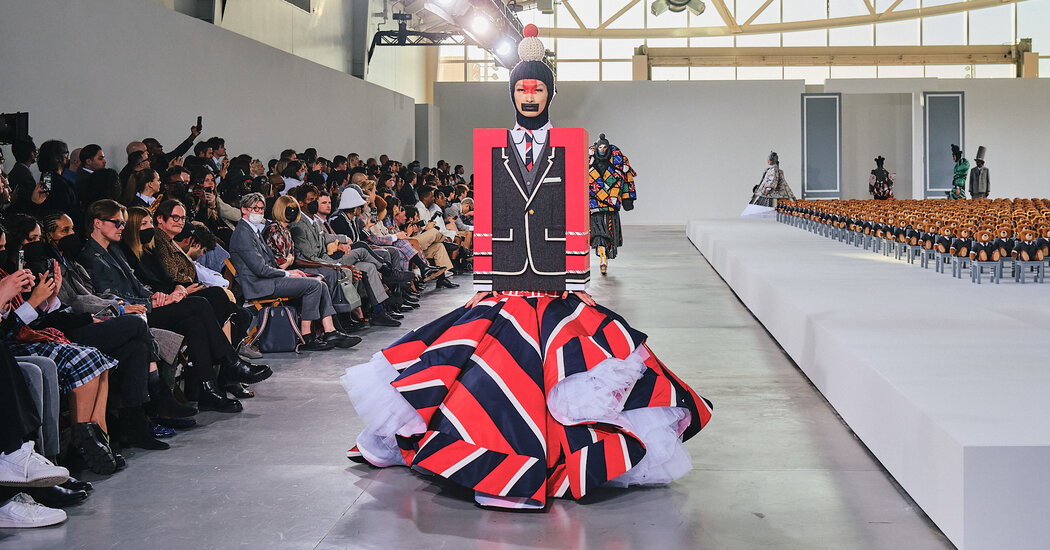
The existential questions of American fashion — what is it? can it be defined? how does it relate to shifting American identity? — were thrust into the cultural conversation in September with the Metropolitan Museum’s fall Costume Institute show, a revisionist look at the “lexicon” of design born in this country.
This week, it’s about to happen again, as the Met unveils Part II of the exhibition: “In America: An Anthology of Fashion,” a bigger, splashier, more historical (though equally nontraditional) survey introduced with the requisite Met Gala on Monday night.
But in a sort of prelude to the event, the designer Thom Browne offered his take on the subject, in the form of a fall collection — shown weeks after the end of the official season to coincide with the Met show — that was effectively an argument for redefining not American but, rather, New York fashion.
And exactly how it relates to the promise and allure of the city itself.
It is a place Mr. Browne characterized in a preview as “an island of misfit toys” — that is, a home for the square pegs, the weirdos and dreamers, the individuals that chafe against the blandness of the crowd. A place that gives them the freedom to find their bliss, to embrace their “true self” and let their freak flags fly. Where citizenry is a state of mind rather than a happenstance of birth.
Then, to illustrate his point, he invited 500 Steiff teddy bears to a room in the Javits Center, outfitted them in little gray shorts suits (his brand signature and personal uniform), sat them in 500 perfectly spaced chairs presided over by a living, emoting bear king in matching shorts, high-heeled boots and a towering hat, and held a “Teddy Talk.”
Sometimes a show is just a way to sell clothes, but sometimes it is a whole camp intellectual discourse.
(For anyone wondering, there were real guests, too, including Danai Gurira, Jon Batiste, David Harbour and Amandla Stenberg, also in shrunken Thom Browne suits, many of them clutching little teddy bear bags.)
It started with the gray tailored suits on which Mr. Browne built his business: twisted versions of midcentury cog-in-the-machine classics in mismatched, patched-together Harris tweeds, inset or detailed with brightly striped rep tie silks. They were just off enough to transform the whole idea of “the suit” into something a little more interesting.
There were multiple variations on the theme (at least 25 shades of them): car coats and gold-buttoned schoolboy jackets and pleated skirts and narrow trousers with big cuffs at the mid-calf, arranged and rearranged into a whole nursery rhyme’s worth of harmonious compositions for both men and women. (Mr. Browne dispensed with gender separation in his shows years ago.)
The suits were also, it turned out, doppelgängers for the “adults” in the room — the outer, socially acceptable, responsible versions of ourselves we don for the world — and simply a prelude to a parade of inner children: high-concept, surrealist versions of the same outfits spliced with toy chest memories. So white shirt sleeves became Slinkys dangling to the floor or giant, stuffed animal lobster claws; a cable knit tennis sweater was transformed into an enormous wearable not-rubber ball.
One doll-like crinoline skirt was seven feet wide; a toy soldier’s top was actually a trompe l’oeil wood box atop an explosive striped silk skirt; a cable-knit punch-and-sew-kit gown was woven from giant ropes weighing 80 pounds. Lace-up ankle boots had high heels made of hand-painted children’s alphabet blocks. Leather bags dangled teddy bear legs or came with wheels so they could be towed along behind.
It was all fun and games (and a little Comme des Garçons) until you realized the work that had gone into each garment.
Which, along with the pop urban psychology, was the point. New York fashion is often dismissed as “commercial” and not as “creative” as fashion in Paris and London; it’s born out of Seventh Avenue and the garment district rather than couture ateliers and art schools. Mr. Browne has taken it upon himself to prove otherwise, to demonstrate that you can have a business and imagination, too.
He sells suits — and, despite the fact that suits have gotten a pretty bad name recently, his looked notably good. They were the kind of not exactly normal clothes that made you sit up and suddenly think, Yeah, maybe that’s exactly the kind of garment that would solve my “what do I wear when I go back to work?” conundrums.
But he also frames those suits with unapologetically ridiculous (sometimes overly mannered, but always interesting) flights of fancy that give them life and a kind of soul. The ability to do that — to have soaring sales and wackiness, too — is what New York gave him, when he arrived as a misfit toy without any formal fashion training via Notre Dame and Allentown, Pa.
His clothes are a reminder of what is possible. Perhaps because of that, what his show ultimately recalled was not so much a children’s story as a different kind of book entirely: N.K. Jemisin’s urban-fantasy ode to New York, “The City We Became.”
A place woven from “reality and legends.”






